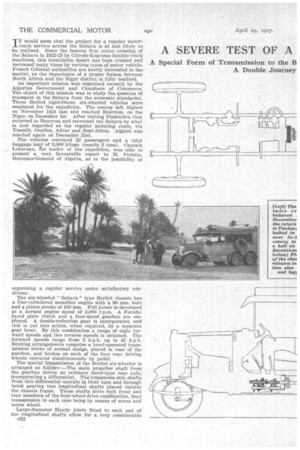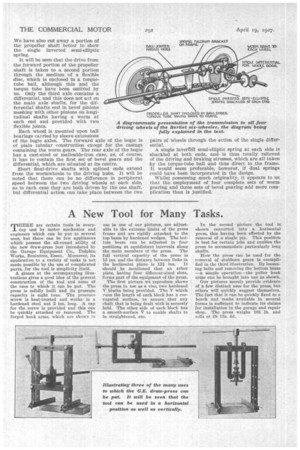A SEVERE TEST OF A ' SIX-WHEELER DESIGN.
Page 54

Page 55

Page 56

If you've noticed an error in this article please click here to report it so we can fix it.
IT would seem that the project for a regular motorcoach service across the Sahara is at last likely to be realized. Since the famous first motor crossing of the Sahara in 1922-23 by Citroen-Kegresse flexible-track machines, this formidable desert has been crossed and recrossed many times by various types of motor vehicle. French Colonial authorities are keenly interested in the matter, as the importance of a proper liaison between North Africa and the Niger district is fully realized.
An important mission was organized recently by the 'Algerian Government and Chambers of Commerce. The object of this mission was to study the question of transpont in the Sahara from the economic standpoint. Three Bernet rigid-frame, six-wheeled vehicles were employed for the expedition. The convoy left Algiers on November 11th last and reached Bourrem, on the Niger, on December 1st. After visiting Timbucktu they returned to Bourrem and recrossed the Sahara by what is now regarded as the regular motoring route, via Tessalit, Ouallen, Adrar and Beni-Abbes. Algiers was reached again on December 31st.
The vehicles conveyed 22 passengers and a total baggage load of 3,000 kilogs. (nearly 3 tons). Captain Lehureau, The leader of the expedition, was able to present a very favourable report to M. Violette, Governor-General of Algeria, as to the possibility of organizing a regular service under satisfactory conditions.
The six-wheeled " Sahara " type Berliet chassis has a four-cylindered monobloe engine with a 90 mm. bore and a piston stroke of 130 ram. Full power is developed at a normal engine speed of 2,000 r.p.m. A Ferodofaced plate clutch and a four-speed gearbox are employed. A double-reduction gear is incorporated, and this is put into action, when required, by a separate gear lever. By this combination a range of eight forward speeds and two reverse speeds is obtained. The forward speeds range from 2 k.p.h. up to 42 k.p.h. Braking arrangements comprise a hand-operated transmission brake of normal design, placed in rear of the gearbox, and brakes on each of the four rear driving wheels operated simultaneously by pedal.
The special transmission of the Berliet six-wheeler is arranged as follows :—The main propeller shaft from the gearbox drives an ordinary bevel-type rear axle, incorporating a differential. The transverse side shafts from this differential operate in their turn and through bevel gearing two longitudinal shafts placed outside the chassis frame. These shafts drive both front and rear members of the four-wheel-drive comfiination, final transmission in each case being by means of worm and worm wheel.
Large-diameter Hardy joints flitted to each end of the longitudinal shafts allow for a very considerable 032
vertical displacement of the driving axles in relation to each other.
The rear is suspended on single cantilever springs, the springing of the forward end of the chassis being by ordinary half-elliptic& Connecting .rods—two on each side—mounted externally to the chassis, and forming a parallelogram, transmit the torque from the front driving axle to the rear one. The usual type of torquetube propeller-shaft casing takes up the reaction from the rear driving axle, as the casing of the latter is in one with the differential casing. Ball-type universal joints are fitted to the ends of the connecting rods which form the side parallelograms. Twin wheels are fitted to each of the driving axles and 860 mm. by 160 mm. low-pressure tyres are employed all round— at both front and rear. The front axle is of a very simple type and no front-wheel brakes are used.
The wheelbase of the Berliet machine is 3 metres 475 (11 ft. 5 ins.) and the front track 1 metre 535 lslightly over 5 ft.). The vehicle can turn in a radius of 7 m. 50 (a little more than 24 ft. 6 ins.).
The special bodies fitted to the Berliet for Sahara work provide seating accommodation for seven persons, in addition to the driver. Fuel and water tanks are housed In a large compartment at the rear of the body, the fuel tanks having a capacity of 100 litres each. There are two of these fuel tanks, and the provision of 200 litres of petrol gives the vehicle a very big radius of action without refilling.
The substantial roof of the car provides ample space for baggage. Rolling side curtains with mica windows are provided. These curtains are made to fit particu larly well when milled down, in order to exclude dust
and fine sand. Extra locker space is provided under Th each of the passenger's seats.. The overall dimensions of the vehicle are :—Length, 5 m. 500 (not quite 18 ft.) ; width, 2 m. 100 (nearly 7 ft.). Spare wheels are carried on the roof, which is provided with a luggage rail and is reinforced.
The construction of the six-wheeled Berliet has been oonsidered from the point of view of the need for covering bong distances in varied country presenting certain risks and having soft ground to travel over. The vehicle, therefore, must be supple and reliable to the utmost degree. The body has to provide the maximum of comfort attainable under the conditions of operation, because a fortnight of travel across a desert calls for measures of amelioration, otherwise it would not be repeated and it would not be recommended to others. Naturally, as the route becomes more and more used, improvements in vehicles and in the number and equipment of. rest-houses can be made, but at first every effort must be expended in securing initial development under difficult conditions.
In order that our readers should be able thoroughly to understand the semi-bogie and final-drive mechanism of this most interesting six-wheeler, we have had drawn a diagrammatic view of the layout of these parts at the off side only of the semi-bogie, although, of course, the propeller shaft and differential have been included.
We have also cut away a portion of the propeller shaft better to show the single inverted semi-elliptic spring.
It will be seen that the drive from the forward portion of the propeller shaft is taken to a second portion through the medium -of a flexible disc, which is enclosed in a torquetube ball, although this and the torque tube have been omitted by us. Only the third axle contains a differential, and this does not -act on the main axle shafts, for the differential shafts end in bevel pinions meshing with other pinions on longitudinal shafts having a worm at each end and provided with two flexible joints.
Each wheel is mounted upon ball bearings carried by sleeve extensions of the bogie axles. The forward axle of the bogie is of plain tubular construction except for the casings_ containing the worm gears. The rear axle of the bogie has a cast-steel or malleable-iron case, as, of course, It has to contain the first set of bevel gears and the differential, which are situated at its centre.
Short final-drive shafts with splined ends extend from the worrawheels to the driving hubs. It will be noted that there can be no difference in peripheral speed between the two driving wheels at each side, as in each case they are both driven by the one shaft, but differential action can take place between the two pairs of wheels through the action of the single differ ential. • A single inverre semi-elliptic spring at each side is shackled at both ends, and is thus totally relieved of the driving and braking stresses, which are all taken by the torque-tube bail and thus direct to the frame. It would seem preferable, however, if dual springs could have been incorporated in the design.
Whilst possessing much originality, it appears to us that the employment of four complete sets of worm gearing and three sets of bevel gearing add more complication than is justified.












































































































